
Prairies are ecosystems considered part of the temperate grasslands, savannas, and shrublands biome by ecologists, based on similar temperate climates, moderate rainfall, and a composition of grasses, herbs, and shrubs, rather than trees, as the dominant vegetation type. Temperate grassland regions include the Pampas of Argentina, Brazil and Uruguay, and the steppe of Ukraine, Russia and Kazakhstan. Lands typically referred to as "prairie" tend to be in North America. The term encompasses the area referred to as the Interior Lowlands of Canada, the United States, and Mexico, which includes all of the Great Plains as well as the wetter, hillier land to the east.
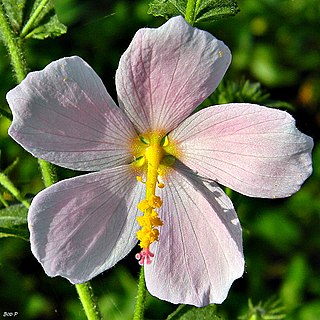
Kosteletzkya pentacarpos, the seashore mallow, also known as the saltmarsh mallow, sweat weed, Virginia saltmarsh mallow, or hibiscus à cinq carpelles, is an herb found in marshes along the eastern seashore of North America, parts of coastal Southern Europe, southwestern Russia, and Western Asia.

Juncaceae is a family of flowering plants, commonly known as the rush family. It consists of 8 genera and about 464 known species of slow-growing, rhizomatous, herbaceous monocotyledonous plants that may superficially resemble grasses and sedges. They often grow on infertile soils in a wide range of moisture conditions. The best-known and largest genus is Juncus. Most of the Juncus species grow exclusively in wetland habitats. A few rushes, such as Juncus bufonius are annuals, but most are perennials.
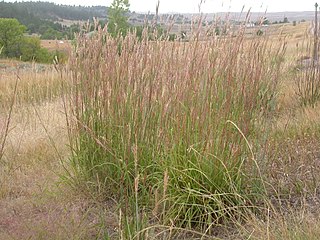
Andropogon gerardi, commonly known as big bluestem, is a species of tall grass native to much of the Great Plains and grassland regions of central and eastern North America. It is also known as tall bluestem, bluejoint, and turkeyfoot.

Juncus effususis a perennial herbaceous flowering plant species in the rush family Juncaceae, with the common names common rush or soft rush. In North America, the common name soft rush also refers to Juncus interior.

Juncus acutus, the spiny rush, sharp rush or sharp-pointed rush, is a flowering plant in the monocot family Juncaceae. It is native to the Americas, Northern and Southern Africa, Western and Southern Europe and West Asia, and is found in a variety of wet habitats, such as bogs, fens, meadows, and salt marshes, and along the edges of ponds and lakes.
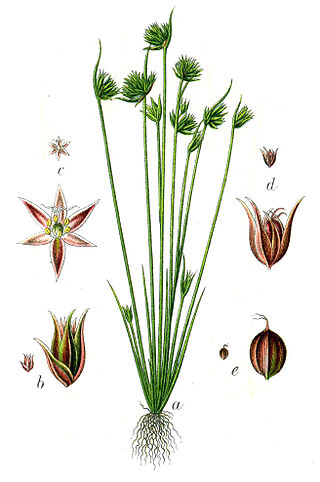
Juncus capitatus is a species of rush known by the common names dwarf rush and leafybract dwarf rush. It is native to Europe, Asia and North Africa. It is also an introduced species in parts of North America such as California and the Gulf Coast. It grows in moist areas, such as wet sand, vernal pools, and ditches.
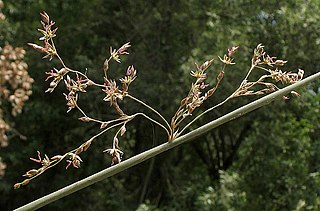
Juncus textilis is a species of rush known by the common name basket rush. It is endemic to California, where it grows along the coast and in the coastal mountain ranges of the southern half of the state.

The Tusket River is a Canadian river located in Nova Scotia's Yarmouth County.

Juncus kraussii commonly known as salt marsh rush, sea rush, jointed rush, matting rush or dune slack rush, is of the monocot family Juncaceae and genus Juncus. It grows in salt marshes, estuarine and coastal areas.
Saltmarsh rush or salt marsh rush is a common name for several plants and may refer to:
Oskar Eric Gunnar Hultén was a Swedish botanist, plant geographer and 20th century explorer of The Arctic. He was born in Halla in Södermanland. He took his licentiate exam 1931 at Stockholm University and obtained his doctorate degree in botany at Lund University in 1937. In his thesis, he coined the term Beringia for the ice-age land bridge between Eurasia and North America. From 1945 to 1961, he was a professor and head of the Botany Section at the Swedish Museum of Natural History. In 1953, he was elected to the Royal Swedish Academy of Sciences as member number 977.
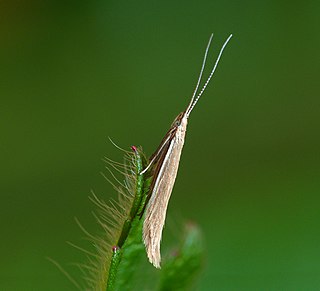
Coleophora glaucicolella is a moth of the family Coleophoridae, found in Asia, Europe and North America. It occurs in forest-steppe biotopes, wet meadows and meadow-steppe.
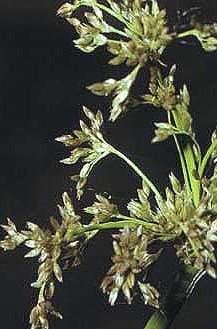
Juncus roemerianus is a species of flowering plant in the rush family known by the common names black rush, needlerush, and black needlerush. It is native to North America, where its main distribution lies along the coastline of the southeastern United States, including the Gulf Coast. It occurs from New Jersey to Texas, with outlying populations in Connecticut, New York, Mexico, and certain Caribbean islands.

Juncus planifolius is a species of rush, commonly known as broadleaf rush, broad-leaved rush, or grass-leaved rush. It naturally occurs in Australia, New Zealand, Hawaii and South America.

Oreojuncus trifidus is a species of rush known by the common names highland rush and three-leaved rush. It is native to the Northern Hemisphere, where it is an arctic/montane species with an amphi-atlantic distribution.

Juncus australis is a species of rush known by the common names austral rush, leafless rush and wīwī. The species is native to south-eastern Australia and New Zealand, where it can be found around bodies of water. Its habitat is wet or seasonally wet grasslands and woodlands, and it can grow in dense and damp soil along rivers and creeks. It is a rhizomatous perennial rush that grows up to 120 centimetres tall. The plant flowers in clusters, with dense heads at the tip of the stem.

Juncus inflexus, the hard rush, is a species of flowering plant in the family Juncaceae, native to Europe, Asia and Africa, and introduced in Sri Lanka, Java, Île Amsterdam and Île Saint-Paul, Victoria in Australia, New Zealand, Uruguay, and eastern North America. It is a glycophyte (non-halophyte).
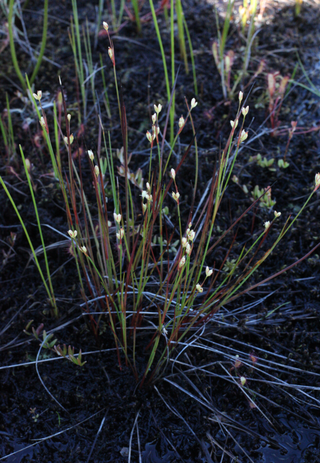
Juncus stygius, called the bog rush and moor rush, is a species of flowering plant in the genus Juncus, with a high circumboreal distribution, never reaching further south than Switzerland, Korea and Upstate New York.

Juncus triglumis, called the three-flowered rush, is a species of flowering plant in the genus Juncus, native to the subarctic and subalpine Northern Hemisphere. It is typically found in calcareous tundra habitats and arcto-alpine fens. It is often found in association with Carex atrofusca and Carex bicolor in the so-called Caricion bicolori-atrofuscae alliance.


















